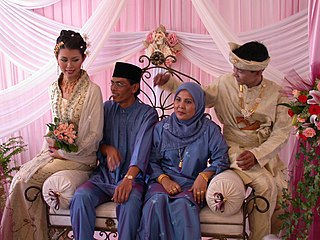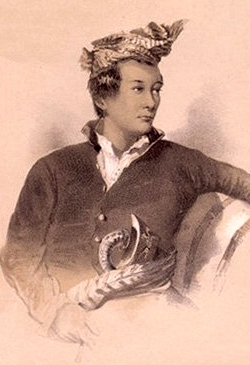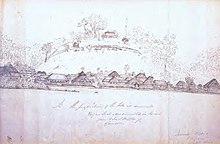
The Straits Settlements were a group of British territories located in Southeast Asia. Originally established in 1826 as part of the territories controlled by the British East India Company, the Straits Settlements came under British Raj control in 1858 and then under direct British control as a Crown colony on 1 April 1867. In 1946, following the end of the Second World War and the Japanese occupation, the colony was dissolved as part of Britain's reorganisation of its Southeast Asian dependencies in the area.

Sir Thomas Stamford Bingley Raffles was a British colonial official who served as the Lieutenant-Governor of the Dutch East Indies between 1811 and 1816, and Lieutenant-Governor of Bencoolen between 1818 and 1824. He is best known mainly for his founding of modern Malaysia and Singapore.

Malay Singaporeans are a local ethnic group in Singapore. Recognised as the indigenous people of the country, the group is defined as Singaporean who is of Malay ethnicity or, whose ancestry originates from the Malay world. Local Malay Singaporeans constitute 15% of the country's citizens, making them the second largest ethnic group in Singapore after Chinese Singaporeans.

The Johor Sultanate was founded by Malaccan Sultan Mahmud Shah's son, Sultan Alauddin Riayat Shah II in 1528. Johor was part of the Malaccan Sultanate before the Portuguese conquered Malacca's capital in 1511. At its height, the sultanate controlled modern-day Johor, Pahang, Terengganu, and territories stretching from the river Klang to the Linggi and Tanjung Tuan, Muar, Batu Pahat, Singapore, Pulau Tinggi and other islands off the east coast of the Malay peninsula, the Karimun islands, the islands of Bintan, Bulang, Lingga and Bunguran, and Bengkalis, Kampar and Siak in Sumatra. During the colonial era, the mainland part was administered by the British, and the insular part by the Dutch, thus breaking up the sultanate into Johor and Riau. In 1946, the British section became part of the Malayan Union. Two years later, it joined the Federation of Malaya and subsequently, the Federation of Malaysia in 1963. In 1949, the Dutch section became part of Indonesia.

William Farquhar was a Scottish colonial administrator employed by the East India Company, who served as the sixth Resident of Malacca between 1813 and 1818, and the first Resident of Singapore between 1819 and 1823.

Fort Canning Hill, formerly Government Hill, Singapore Hill and Bukit Larangan, is a small hill, about 48 metres (157 ft) high, in the southeast portion of the island city-state of Singapore, within the Central Area that forms Singapore's central business district. It is named after Viscount Charles John Canning, the first Viceroy of India. Although small in physical size, it has a long history intertwined with that of the city-state due to its location as the highest elevation within walking distance to the city's civic district, within the Downtown Core. It is also a popular location for exhibitions, concerts and outdoor recreation.

The term "British Malaya" loosely describes a set of states on the Malay Peninsula and the island of Singapore that were brought under British hegemony or control between the late 18th and the mid-20th century. Unlike the term "British India", which excludes the Indian princely states, British Malaya is often used to refer to the Federated and the Unfederated Malay States, which were British protectorates with their own local rulers, as well as the Straits Settlements, which were under the sovereignty and direct rule of the British Crown, after a period of control by the East India Company.

Sultan Sultan Ali Iskandar Shah I ibni almarhum Sultan Ahmad Hussein Muazzam Shah I was the 19th Sultan of Johor, who succeeded his father, Sultan Hussein after the latter died of natural cause in 1835. Over the next twenty years, Sultan Ali's claims to the office of Sultan of Johor were only recognised by some merchants and a few Malays. Like his father, Sultan Ali's was much of a puppet monarch and played a minimal role in the administrative affairs of the state, which came under the charge of the Temenggong and the British. In 1855, Sultan Ali ceded the sovereignty rights of Johor to Temenggong Daeng Ibrahim, in exchange for a formal recognition as the "Sultan of Johor" by the British and a monthly allowance. Following the secession of Johor, Sultan Ali was granted administrative charge over Muar until his death in 1877, and in most administrative matters, was often styled as the "Sultan of Muar".

The history of the modern state of Singapore dates back to its founding in the early 19th century; however, evidence suggests that a significant trading settlement existed on the island in the 14th century. The last ruler of the Kingdom of Singapura, Parameswara, was expelled by the Majapahit or the Siamese before he founded Malacca. Singapore then came under the Malacca Sultanate and subsequently the Johor Sultanate. In 1819, British statesman Stamford Raffles negotiated a treaty whereby Johor will allow the British to locate a trading port on the island, ultimately leading to the establishment of the Crown colony of Singapore in 1867. Important reasons for the rise of Singapore were its nodal position at the tip of the Malay Peninsula flanked by the Pacific and Indian Oceans, the presence of a natural sheltered harbour, as well as its status as a free port.

The early history of Singapore refers to its pre-colonial era before 1819, when the British East India Company led by Stamford Raffles established a trading settlement on the island and set in motion the history of modern Singapore.
Sultan Hussein Mua'zzam Shah ibni Mahmud Shah Alam was the 18th ruler of Johor-Riau. He signed two treaties with Britain which culminated in the founding of modern Singapore; during which he was nominally given recognition by the British as the Sultan of Johor and Singapore in 1819 and the Sultan of Johor in 1824.
Tun Habib Abdul Majid bin Tun Ali bin Tun Muhammad was the 19th Bendahara of the Johor Sultanate during the late 17th century. The Johor Sultanate under Sultan Mahmud Shah II saw a gradual decline of royal authority during Tun Habib's tenure as the Bendahara of Johor. Internal challenges within the Sultanate faced by Tun Habib consolidated his power as the Bendahara, in which case the Bendahara monopolised legitimate authority over the Johor Sultanate by the 1690s. After his death, Tun Habib's descendants spanned throughout the Johor Sultanate and established ruling houses in Riau-Lingga, Johor, Pahang and Terengganu.
Events from the year 1819 in Singapore.

The Kingdom of Singapura was an Indianised Malay Hindu-Buddhist kingdom thought to have been established during the early history of Singapore upon its main island Pulau Ujong, then also known as Temasek, from 1299 until its fall in 1398. Conventional view marks c. 1299 as the founding year of the kingdom by Sang Nila Utama, whose father is Sang Sapurba, a semi-divine figure who according to legend is the ancestor of several Malay monarchs in the Malay World. The historicity of this kingdom based on the account given in the Malay Annals is uncertain, and many historians only consider its last ruler Parameswara a historically attested figure. Archaeological evidence from Fort Canning Hill and the nearby banks of the Singapore River has nevertheless demonstrated the existence of a thriving settlement and a trade port in the 14th century.
Mahmud Ri’ayat Shah Zilu’llah fil’Alam Khalifat ul-Muminin ibni al-Marhum Sultan ‘Abdu’l Jalil Shah was the 15th Sultan of Johor and Johor's dependencies who reigned from 1770 to 1811.
Sri Paduka Dato' Bendahara Sri Maharaja Tun Ali ibni Almarhum Dato' Bendahara Paduka Raja Tun Koris was the 23rd and the last Bendahara of Johor Sultanate, and the fourth Raja Bendahara of the Pahang Kingdom who reigned from 1806 to 1857.

The Istana Lama was a palace once located at Telok Blangah in Singapore. It was first built for Temenggong Abdul Rahman in 1824. It had since been demolished in 1954.
Dato Temenggong Daeng Abdul Rahman bin Tun Daeng Abdul Hamid was the Temenggong of Johor during the Bendahara dynasty. He was best known of being instrumental in the Treaty of Singapore with the British East India Company in 1819.

Raja Temenggong Tun Daeng Ibrahim bin Temenggong Daeng Abdul Rahman was the Temenggong of Johor and later the de facto Maharaja of Johor from 1855 to 1862.




















